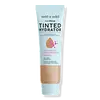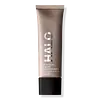What's inside
What's inside
 Key Ingredients
Key Ingredients

 Benefits
Benefits

 Concerns
Concerns

No concerns
 Ingredients Side-by-side
Ingredients Side-by-side

Water
Skin ConditioningCyclopentasiloxane
EmollientButylene Glycol
HumectantGlycerin
HumectantDisteardimonium Hectorite
StabilisingCetyl PEG/PPG-10/1 Dimethicone
EmulsifyingLauryl PEG-10 Tris(Trimethylsiloxy)Silylethyl Dimethicone
EmulsifyingPhenoxyethanol
PreservativeMagnesium Sulfate
Triethoxycaprylylsilane
Ethylhexylglycerin
Skin ConditioningDimethicone/Vinyl Dimethicone Crosspolymer
Skin ConditioningSqualane
EmollientSodium Hyaluronate
HumectantHydrolyzed Hyaluronic Acid
HumectantCI 77891
Cosmetic ColorantIron Oxides
CI 77492
Cosmetic ColorantCI 77499
Cosmetic ColorantWater, Cyclopentasiloxane, Butylene Glycol, Glycerin, Disteardimonium Hectorite, Cetyl PEG/PPG-10/1 Dimethicone, Lauryl PEG-10 Tris(Trimethylsiloxy)Silylethyl Dimethicone, Phenoxyethanol, Magnesium Sulfate, Triethoxycaprylylsilane, Ethylhexylglycerin, Dimethicone/Vinyl Dimethicone Crosspolymer, Squalane, Sodium Hyaluronate, Hydrolyzed Hyaluronic Acid, CI 77891, Iron Oxides, CI 77492, CI 77499
Ethylhexyl Methoxycinnamate 6.7%
UV AbsorberTitanium Dioxide 3.1%
Cosmetic ColorantZinc Oxide 1.3%
Cosmetic ColorantWater
Skin ConditioningOctyldodecyl Neopentanoate
EmollientButyloctyl Salicylate
Skin ConditioningDimethicone
EmollientButylene Glycol
HumectantMethyl Trimethicone
Skin ConditioningNiacinamide
SmoothingCetyl PEG/PPG-10/1 Dimethicone
EmulsifyingLauryl PEG-9 Polydimethylsiloxyethyl Dimethicone
Skin ConditioningDiethylhexyl Succinate
EmollientLaureth-4
EmulsifyingTocopheryl Acetate
AntioxidantSodium Hyaluronate
HumectantLecithin
EmollientRosa Hybrid Flower Extract
Skin ConditioningPyrus Malus Fruit Extract
Skin ConditioningLens Esculenta Fruit Extract
Skin ConditioningCitrullus Lanatus Fruit Extract
Skin ConditioningLycium Chinense Fruit Extract
AntioxidantPalmitoyl Hexapeptide-14
Skin ConditioningPeat Extract
Skin ConditioningGold
Cosmetic ColorantSodium Lactate
BufferingMethicone
EmollientSodium PCA
HumectantHydrolyzed Wheat Protein/Pvp Crosspolymer
Glycerin
HumectantCI 77120
Cosmetic ColorantMagnesium Sulfate
Dimethyl Isosorbide
SolventMaltodextrin
AbsorbentTriethoxycaprylylsilane
Dimethicone Crosspolymer-3
Skin ConditioningSilica
AbrasiveAluminum Hydroxide
EmollientDimethicone/PEG-10/15 Crosspolymer
Trimethylsiloxysilicate
EmollientHexylene Glycol
EmulsifyingIsostearic Acid
CleansingCaprylyl Glycol
EmollientStearic Acid
CleansingPolyglyceryl-2 Triisostearate
EmulsifyingDipentaerythrityl Tri-Polyhydroxystearate
EmollientDipropylene Glycol
HumectantSodium Citrate
BufferingBHT
AntioxidantDisodium EDTA
Sodium Benzoate
MaskingPotassium Sorbate
PreservativePhenoxyethanol
PreservativeMica
Cosmetic ColorantCI 77891
Cosmetic ColorantCI 77491
Cosmetic ColorantCI 77492
Cosmetic ColorantCI 77499
Cosmetic ColorantCI 77163
Cosmetic ColorantEthylhexyl Methoxycinnamate 6.7%, Titanium Dioxide 3.1%, Zinc Oxide 1.3%, Water, Octyldodecyl Neopentanoate, Butyloctyl Salicylate, Dimethicone, Butylene Glycol, Methyl Trimethicone, Niacinamide, Cetyl PEG/PPG-10/1 Dimethicone, Lauryl PEG-9 Polydimethylsiloxyethyl Dimethicone, Diethylhexyl Succinate, Laureth-4, Tocopheryl Acetate, Sodium Hyaluronate, Lecithin, Rosa Hybrid Flower Extract, Pyrus Malus Fruit Extract, Lens Esculenta Fruit Extract, Citrullus Lanatus Fruit Extract, Lycium Chinense Fruit Extract, Palmitoyl Hexapeptide-14, Peat Extract, Gold, Sodium Lactate, Methicone, Sodium PCA, Hydrolyzed Wheat Protein/Pvp Crosspolymer, Glycerin, CI 77120, Magnesium Sulfate, Dimethyl Isosorbide, Maltodextrin, Triethoxycaprylylsilane, Dimethicone Crosspolymer-3, Silica, Aluminum Hydroxide, Dimethicone/PEG-10/15 Crosspolymer, Trimethylsiloxysilicate, Hexylene Glycol, Isostearic Acid, Caprylyl Glycol, Stearic Acid, Polyglyceryl-2 Triisostearate, Dipentaerythrityl Tri-Polyhydroxystearate, Dipropylene Glycol, Sodium Citrate, BHT, Disodium EDTA, Sodium Benzoate, Potassium Sorbate, Phenoxyethanol, Mica, CI 77891, CI 77491, CI 77492, CI 77499, CI 77163
 Reviews
Reviews

Ingredients Explained
These ingredients are found in both products.
Ingredients higher up in an ingredient list are typically present in a larger amount.
Butylene Glycol (or BG) is used within cosmetic products for a few different reasons:
Overall, Butylene Glycol is a safe and well-rounded ingredient that works well with other ingredients.
Though this ingredient works well with most skin types, some people with sensitive skin may experience a reaction such as allergic rashes, closed comedones, or itchiness.
Learn more about Butylene GlycolThis ingredient is a high molecular weight silicone. It has emulsifying and skin conditioning properties.
Ci 77492 is also hydrated iron III oxide. It's sole purpose is to give a yellow hue to products.
Iron III oxides are classified as inorganic chemicals for coloring.
Synthetically created Ci 77492 is considered safer than those naturally found. This is because the synthetically created version may contain less impurities. Iron oxides are generally non-toxic and non-allergenic.
Learn more about CI 77492Ci 77499 is also hydrated iron III oxide. It is created from mixing red and black iron oxides. This helps give shades of darkness to a product.
Iron III oxides are classified as inorganic chemicals for coloring.
Ci 77891 is a white pigment from Titanium dioxide. It is naturally found in minerals such as rutile and ilmenite.
It's main function is to add a white color to cosmetics. It can also be mixed with other colors to create different shades.
Ci 77891 is commonly found in sunscreens due to its ability to block UV rays.
Learn more about CI 77891Glycerin is already naturally found in your skin. It helps moisturize and protect your skin.
A study from 2016 found glycerin to be more effective as a humectant than AHAs and hyaluronic acid.
As a humectant, it helps the skin stay hydrated by pulling moisture to your skin. The low molecular weight of glycerin allows it to pull moisture into the deeper layers of your skin.
Hydrated skin improves your skin barrier; Your skin barrier helps protect against irritants and bacteria.
Glycerin has also been found to have antimicrobial and antiviral properties. Due to these properties, glycerin is often used in wound and burn treatments.
In cosmetics, glycerin is usually derived from plants such as soybean or palm. However, it can also be sourced from animals, such as tallow or animal fat.
This ingredient is organic, colorless, odorless, and non-toxic.
Glycerin is the name for this ingredient in American English. British English uses Glycerol/Glycerine.
Learn more about GlycerinMagnesium Sulfate is a salt. More specifically, it is an epsom salt, or the bath salt used to help relieve muscle aches.
Despite having ‘sulfate’ in the name, it isn’t a surfactant or cleansing agent like sodium lauryl sulfate. Unlike those sulfates, magnesium sulfate doesn’t have the same cleansing or foaming properties (it's simply a type of salt).
In cosmetics, Magnesium Sulfate is used to thicken a product or help dilute other solids. It is a non-reactive and non-irritating ingredient.
One study shows magnesium deficiency may lead to inflammation of the skin. Applying magnesium topically may help reduce inflammation.
You can find this ingredient in sea water or mineral deposits.
Learn more about Magnesium SulfatePhenoxyethanol is a preservative that has germicide, antimicrobial, and aromatic properties. Studies show that phenoxyethanol can prevent microbial growth. By itself, it has a scent that is similar to that of a rose.
It's often used in formulations along with Caprylyl Glycol to preserve the shelf life of products.
Sodium Hyaluronate is hyaluronic acid's salt form. It is commonly derived from the sodium salt of hyaluronic acid.
Like hyaluronic acid, it is great at holding water and acts as a humectant. This makes it a great skin hydrating ingredient.
Sodium Hyaluronate is naturally occurring in our bodies and is mostly found in eye fluid and joints.
These are some other common types of Hyaluronic Acid:
Learn more about Sodium HyaluronateTriethoxycaprylylsilane is a silicone used to bind and stabilize ingredients.
As an emulsifier, it helps prevent ingredients from separating. This can help elongate the shelf life of products.
Triethoxycaprylylsilane is often used to coat mineral sunscreens ingredients to help give a better feel. It also helps reduce oxidative stress in sunscreens.
Learn more about TriethoxycaprylylsilaneWater. It's the most common cosmetic ingredient of all. You'll usually see it at the top of ingredient lists, meaning that it makes up the largest part of the product.
So why is it so popular? Water most often acts as a solvent - this means that it helps dissolve other ingredients into the formulation.
You'll also recognize water as that liquid we all need to stay alive. If you see this, drink a glass of water. Stay hydrated!
Learn more about Water